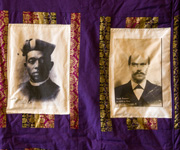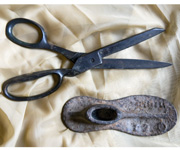Student digitizes local archivist’s collection of Bronzeville residents’ migration stories
By Deva Woodlydeva@uchicago.edu
News Office
 |  |
|
| Photos by Lloyd DeGrane The photographic images preserved in this quilt are from a collection of photos that belong to the International Society of Sons and Daughters of Slave Ancestry, a partner in the Bronzeville/Black Chicagoan Historical Society’s Great Migration exhibition. The inset photo shows Father Augustus Tolton (left), a former runaway slave who came to Chicago and became the first African American Catholic priest in the United States; and Sank Benson (right), who migrated to Chicago from Mississippi. | ||
 |  |
|
| Sherry Williams, a resident of Bronzeville, has collected not only oral histories of the Great Migration from the South to Chicago, but also artifacts that help define the lives of African Americans and the culture they brought to the city. The scissors are a loan to the Bronzeville Historical Society from Pearlie Westbrook, who migrated to Chicago in the early 1950s. They belonged to her mother Beulah Pruitt of Indianola, Miss. The shoemaker form was gifted from Edward “Killer” Shephard, who migrated in the late 1940s from Cary, Miss. The form was used by all the shoemakers in his family. These items and others like them are part of the exhibition, “Great Migration: What They Brought With Them,” opening Saturday, May 16, at the Florence Hotel in Pullman. The newly digitized oral histories also will be available for viewing. | Will Faber teaches Sherry Williams how to convert VHS videotapes to digital format during a workshop he held at the Pullman neighborhood’s historic Florence Hotel. Faber helped digitize Williams’ collection of videotapes on which she recorded, over the span of 11 years, the oral histories of Bronzeville residents, and Bronzeville civic events, architecture and church gatherings. Much of the footage Williams captured includes the personal histories of residents who shared stories of their journeys from the South during the Great Migration. | |
Eric Usner believes that the best scholarship requires praxis—the development of theoretical knowledge and skills through reflection upon real-world practice. Drawing upon models for community-based learning, the postdoc in Ethnomusicology created the course, “Engaging Ethnomusicology,” which pushes student research outside the halls of the University and into the wealth of knowledge and material present in the surrounding South Side communities.
“I wanted students to think about how their academic interest could be articulated in partnership with the shared interests, assets and needs of the larger communities in which they live and work,” Usner said.
Many of the graduate students who took part in the seminar responded with gusto. Will Faber, a first-year Ph.D. student, was one of them.
Faber, a graduate of Knox College who also is a member of the experimental jazz band, El Is a Sound of Joy, and a part-time busker during Chicago’s warm weather season, was very receptive to Usner’s approach. “It makes sense to me to go out and try to understand lived experience, and how music fits into that.”
As part of his final project for “Engaging Ethnomusicology,” he collaborated with Joanie Friedman, the Civic Knowledge Project’s coordinator of the Southside Arts and Humanities Network, to conduct in-depth interviews with some member organizations.
“I met Sherry Williams of the Bronzeville/Black Historical Society through The Network interviews,” Faber remembered. “I was intrigued because she told me that she had a huge collection of footage from the past decade and more of community happenings.”
Williams was surprised that Faber was interested since the scenes from life in Bronzeville that she has collected are not limited to musical performance. “It’s 11 years of all kinds of tape that no one but me had ever seen. It’s full of a lot of different things: architecture, civic events, church meetings and oral histories.
“But Will’s interest was piqued, and he told me that he had the expertise to digitize the material. Faber outlined a plan to catalogue content on the digital videotapes that included creating subject captions. His work comes at a time when our funding has waned. The film is the most important cultural asset of our archives. Many of the historic sites are now demolished.”
When asked why this kind of work appealed to him, Faber said simply, “These are people’s stories, there’s a responsibility to preserve and present them properly.”
Since Faber’s work focuses on American jazz in the middle-20th century, access to the oral histories concerning the Great Migration were of special interest. “These migration stories I’m digitizing and editing for Sherry help me understand the context of somebody like Fred Anderson,” the legendary avant-garde jazz musician who settled in the 1940s in Evanston.
For Williams, Faber’s work serves a much more immediate purpose. On Saturday, May 16, she will open an exhibition at the historic Florence Hotel in Chicago’s Pullman neighborhood called “Great Migration: What They Brought With Them.” The newly digitized oral histories will be available along with art and artifacts that Bronzeville residents donated and collected from their mistaken placement in junk shops and garage sales.
Beyond the exhibition, Williams wants the film archived and accessible to researchers. “It is an amazing resource for people who are passionate about the Bronzeville community. I don’t want the stuff to be on a shelf somewhere, unused and forgotten about. Over the years,” she continues, “folks have allowed me to capture all the things in their lives, and I want the records to be used in a creative way. I want these tapes to open up opportunities for people, especially for Will.”
Faber said he’s enjoying cataloging the films—so much so that he recently gave a digital media workshop for a group of the Historical Society’s volunteers in which he taught, among other things, how to convert VHS tapes to digital formats. “I could say that pragmatically, this volunteering is helping me acquire a lot of research skills. But that’s not really the point. This is the work that I enjoy, and I figure it all ties together eventually.”
Usner, who has kept close tabs on his student’s project even as it transcended the boundaries of the classroom and the quarter, seems to concur. “I don’t think you have to start with music. Music is a part of almost every story because music is the performance of culture, and culture the expression on human experience. While you’re on your way to discovering the music, you develop the interpersonal and research skills that you’ll need to do a kind of work that is accountable to real-life experience.”
As far as Usner is concerned, there is no better kind.
![[Chronicle]](/images/sidebar_header_oct06.gif)